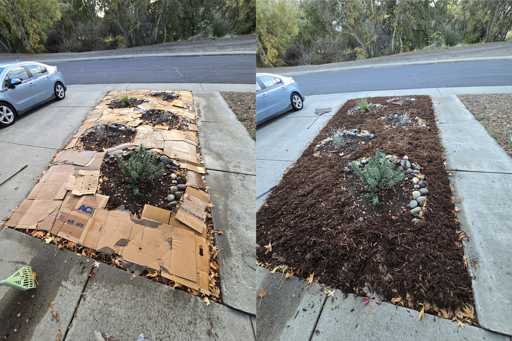- cross-posted to:
- wikipedia@lemmy.world
- cross-posted to:
- wikipedia@lemmy.world
cross-posted from: https://lemmy.world/post/22406409
Picture up top from yours truly, lmao
If you’re thinking of using paper or cardboard make sure that the inks and adhesives used in it are biodegradable and non-toxic.
It seems like a lot of toxicity warnings are based on an industrial scale so I’m curious about the impact of using a couple printed boxes, versus the impact of the next laziest option: synthetic landscaping “fabric” or that thick black plastic material.
There’s some really good research and info on this site: https://www.anourishingharvest.com/
When it comes to chemical pollutants and health I think it’s the concentrations that are more relevant than the scale. Grams of toxins spread over a vegetable garden could easily be worse than tonnes of toxins spread over a big farm.
It’s laborious to measure the amount of known toxins in your soil and even more laborious to measure the health impacts of them, so I just stick to using things that I know the soil can process naturally. Apart from not wanting to poison myself I also don’t want to poison future generations or create a dystopian problem for them to have to fix.
To be honest though, in my experience mulching is a bit overrated and ends up being pretty much the same amount of work/hassle as doing a bit of a digging here and there. Also, digging, weeding and tidying help you to get to know the life of your garden and become more intimate with it, with I think is totally solarpunk :)
There’s another option though. Any paint store/ department sells rolls of plain brown paper for use as a dropcloth. That’s what I use instead of cardboard. It’s not particularly expensive, and it’s as easy to roll out as landscaping fabric.
That sounds cool :) Hopefully it only contains natural fibre. I was surprised to find out recently that toilet tissue has PFAS ‘forever chemicals’ in it, when I had assumed it was just paper. Even this company making natural toilet paper have had problems verifying their supply chain and manufactuting process… I’m totally on the sceptical side of anything which is currently mass produced being free of toxins but that is just me!
A particularly useful approach also to prevent weed growth around existing plants like berry bushes. Old newspapers are just the right size for this.
How does it prevent weeds once the newspaper is gone?
It only prevents it when it’s there.
Thr cardboard/newspaper prevents germination of new weeds, and blocks off light from old weeds, generally killing them.
I used this to reclaim a wild patch into a garden bed with cardboard and pine needles as mulch. Took a few months, but it even killed some blackbeery brambles. They came the fuck back of course, but it was enough to get the patch going right.
Dont use colorful or waxed cardboard, and remove all tape. Its annoying, but better than picking it out of the garden later.
…remove all tape. Its annoying, but better than picking it out of the garden later.
Like removing the teeth from a body before feeding it to your hogs. Easier to do it before than to pick them out after.
ಠ_ಠ
Thank you!
It doesn’t, but keep in mind that most weeds grow from seeds or roots in the immediate vicinity of where they end up. Even if you wipe out all of the above-ground weeds, there are typically thousands of dormant seeds and root fragments that will rapidly repopulate the area in response to the soil disturbance and lack of competition after this removal.
Proper sheet mulching prevents these roots and seeds from immediately repopulating the space. You’ll still have weeds invading from border areas and the occasional long-term dispersal but these will be much smaller in numbers and more easily handled by other methods. If the latent weed population in a larger space can be eliminated then the amount of weeding needed can be very low.
Also, very few weed seeds can establish in more typical mulch material like straw or wood chips. Thick layers of organic material require a large energy reserve to push through, usually provided by an existing root system. So once the process is completed, you can prevent recolonization with more ordinary mulching methods, though you’ll still have to fight at the borders if large weed populations exist there.
Great info, thank you!
Great idea. That stuff is also used as packing paper for packages or moving. I think I’ll start saving it as I get it.
I’ve been using this extensively in my garden / yard over the last few years with great success. We’ve used it in our vegetable garden, our herb / tea garden and now we’re doing it for a section for cut flowers and Dahlias for next year. We haven’t bagged any leaves in the last few years using them and some of our neighbors on our gardens. Sheet mulching for the win






